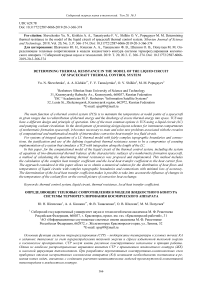Determining thermal resistance in the model of the liquid circuit of spacecraft thermal control system
Автор: Shevchenko Yu. N., Kishkin A.A., Tanasiyenko F.V., Shilkin O.V., Popugayev M.M.
Журнал: Сибирский аэрокосмический журнал @vestnik-sibsau
Рубрика: Авиационная и ракетно-космическая техника
Статья в выпуске: 3 т.20, 2019 года.
Бесплатный доступ
The main function of a thermal control system (TCS) is to maintain the temperature at nodal points of a spacecraft in given ranges due to redistribution of thermal energy and the discharge of excess thermal energy into space. TCS may have a different design and principle of operation. One of the most common options is TCS using a liquid circuit (LC) and pumping coolant circulation. In the development of promising design-layout schemes for instrument compartments of nonhermetic formation spacecraft, it becomes necessary to state and solve new problems associated with the creation of computational and mathematical models of intermediate convective heat transfer in a fluid circuit. For systems of integral equations of a LC thermal model with fairly complex topographic boundaries and connections, the justification and use of the defining (equivalent) thermal resistance seems to be a compromise of counting implementation of a system that simulates a TCS with integration along the length of the LC. In this paper, for the computational model of the liquid circuit of the thermal control system, including the system of equations of two-dimensional thermal balance of the characteristic surfaces of a nonhermetic formation spacecraft, a method of calculating the determining thermal resistances was proposed and implemented. This method includes the calculation of the complex heat transfer coefficient and the local heat transfer coefficient to the heat carrier flow. The approach considered in this paper allows us to obtain a numerical solution for the distribution of heat flows and temperatures of liquid circuits with complex topographic boundaries and connections with minimal loss of accuracy. The determination of the local heat transfer coefficient makes it possible to take into account the influence of changes in the temperature of the coolant flow on the overall picture of convective heat exchange.
Thermal control system, liquid circuit, thermal resistance, local heat transfer coefficient
Короткий адрес: https://sciup.org/148321929
IDR: 148321929 | УДК: 629.78 | DOI: 10.31772/2587-6066-2019-20-3-366-374
Текст научной статьи Determining thermal resistance in the model of the liquid circuit of spacecraft thermal control system
Introduction . One of the indispensable conditions for the reliable functioning of the spacecraft (SC) and its service systems, as well as payload equipment is to ensure the necessary thermal regime of all its elements. To solve this problem, thermal control systems (TCS) are used. The main function of TCS is to maintain the temperature at the nodal points of the spacecraft in the specified ranges due to the redistribution of thermal energy and the discharge of excess thermal energy into outer space [1; 2].
TCS of SC can have a different design and operating principle [3]. One of the most common options is the TCS using a liquid circuit (LC) and pumping circulation of the coolant. Such systems are used in unpressurized spacecraft with an energy ratio of up to 10 kW.
When developing promising structural and layout schemes of instrument compartments of unpressurized spacecraft, it becomes necessary to formulate and solve new problems associated with the creation of computational and mathematical models of intermediate convective heat transfer in a liquid circuit [4]. At the previous stages of the study, the authors of [5; 6] obtained systems of equations for the liquid circuit in a general form, not determined by thermal resistances.
Statement of the research problem. The thermal regime of TCS is determined by the positional heat load from the spacecraft instruments, solar heat flux uniformly distributed over the outer cover, radiation into outer space, as well as convective heat and mass transfer in the liquid circuit of the temperature control system. For this case, the authors of [5] obtained a system of thermal balances of a TCS of SC by characteristic isothermal surfaces, reduced to a form that allows a numerical solution.
Most of the equations of the thermal model of LC of TCS of spacecrafts contain finite (integral) temperature differences, which makes it possible to use the onedimensional, often used analogy of thermal resistance to simulate heat transfer – an analogue of Ohm's law for an electric circuit:
Q = Δ T
RT where Q is the heat flux, ΔT is the temperature head, RT is the equivalent heat resistance.
For systems of integral equations of the thermal model of the LC with sufficiently complex topographic boundaries and relationships, the justification and use of the determining (equivalent) thermal resistance seems to be a compromise in the counting implementation of a system simulating the TCS of a spacecraft with integration over the length of the LC.
The aim of this work is to determine the equivalent thermal resistances taking into account the design features of LC and panels, the features of local heat transfer in the circuit
Mathematical model of complex thermal resistance. Let us consider sequentially the typical (used in the construction of real TCS of spacecrafts) types of thermal resistances in the complication of the boundary and regime conditions [7; 8]. In fig. 1 a fragment of the heat transfer circuit in the TCS of the Δ x i length is shown, including a honeycomb panel on the south side of the spacecraft (with the index s – south) with a liquid circuit pipe placed on it. We denote the outer surface area of the honeycomb panel by F 1 , the contact area of the honeycomb panel and the heel of the pipe by F 2 , the internal surface area of the pipe washed by the coolant by F 3 , the width of the honeycomb section by l 1 S , the width of the heel of the pipe by l 2 S , the thickness of the honeycomb panel by b 12 S
We assume that the main one-dimensional heat equivalent (see fig. 1) is the heat transfer process – the method of heat conduction from the F 1 plane to the F 2 plane, and the planes are not equal: F 1 = l 1 S ∙ Δ x i > F 2 = = l 2 S ∙ Δ x i , which corresponds to the simulation case of heat transfer from the surface of the southern honeycomb panel – F 1 = l 1 S ∙ l 1 Sx ; F 1 > F 2 ; l 1 S > l 2 S .
We write the one-dimensional heat conduction equation on the finite length of the integration body Δ xi :
Δ Q i =- dT λ⋅ lS ⋅∆ xi db
where λ is the thermal conductivity coefficient, b is the wall thickness.
Note that ls in the first approximation (in the case of the equivalent thermal resistance) is a linear function of thickness b , with boundary values l S = l 1 S at b = 0; l S = l 2 S at b = b S .
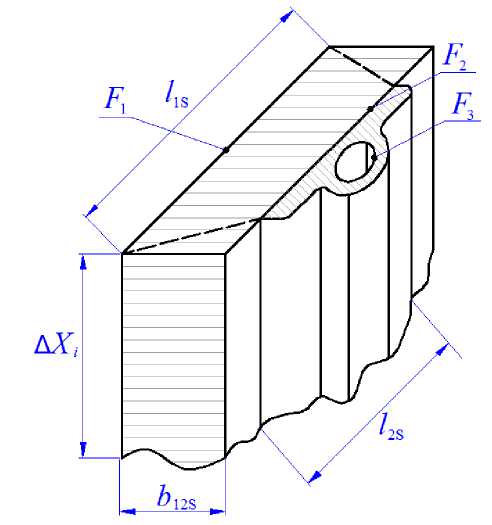
Fig. 1. Fragment of the heat transfer circuit for calculation of the thermal equivalent
Рис. 1. Фрагмент контура теплопередачи для вычисления теплового эквивалента
Let lS = a 1 + a 2 ∙b , then l 1 S = a 1; l 2 S = l 1 S + a 2 ∙b ; b =
= ( l 2 S – l 1 S )/ bS , and the linear function has the form
- S = 1 1S + . ■ - b . (2)
bS or
Equation (1) acts as a general connection for the system of equations of thermal balances of the LC of TCS in the case of unequal non-adiabatic surfaces with thermal conductivity. In view of (2), we transform (1) and separate the variables
X - A x i l 2 S -1 S
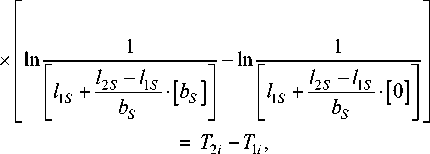
A Q i - db
“ -Axi , . l 2 S - - 1 S
- 1 S + b
L bs J
— dT,
where T 1 i , T 2 i are the temperatures of the outer and inner surfaces of the honeycomb panel at the integration step.
After transformations and reductions, we have
for integration (3), it is necessary to replace the variables
^^^^^^B
a Q i
b
•
X - A xi l 2 S
^^^^^^B
l 1 S
1 1
• In--In— = T 2
l 2 S
l1 S J
2 i
^^^^^^B
T 1 i ,
A Q i b s
---
X • A x i 1 2 S — 1 1S
d - 1 S + l ’ S -S - b
= dT
The integral for (4) at the boundaries b 0 b S and T T T 1 2 i i has the form
a Qi
b
•
X - A xi l 2 S
^^^^^^B
l 1 S
• ln -2 S 1 = T 2 i
v l 1 S
^^^^^^B
T 1 i .
For the final heat flux (5) is converted to
a Q i =
T 2 i
^^^^^^B
T 1 i
T 2 i
^^^^^^B
T 1 i
R X i
b
,
X - Axi - ( l 2 S l1 S )
• ln l l 2 S
l 1 S
^^^^^^»
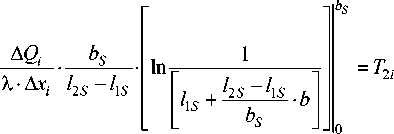
T 1 i ,
^^^^^^B
where the determining thermal resistance at the integration step Δ x i in the case of unequal boundary non-adiabatic surfaces has the form:
R X12 i =
bS 12 in I l 2 S
X-Axi ’( l 2 S - -1S ) V -1S
Bringing the thermal resistance from the surface F 2 to the surface F 3 (which corresponds to the surface of the shelf F 2 = l 2 S ∙ Δ x i , and the inner surface F 3 = π ∙d i ∙ Δ x i of the liquid heat and mass transfer circuit) to the equivalent form (7) requires preliminary numerical calculations, since the surfaces F 2 and F 3 is non-equidistant, and the surface of F 3 is essentially non-linear (circular cylinder). For the nomenclature of the profiles used (fig. 2), the heel width of the pipe l 2 S and the circumference of the inner surface of the pipe l 3 S are known.
We determine the thermal resistance Rλ23 = ΔT/Q in the area of real thermal powers, then using the known l2S and l3S, we determine the equivalent thickness from an expression similar to (7), and for convenience of conver- sion we equate Δxi = 1 m (i. e., we estimate the thermal power reduced to a running meter), then with the calculated thermal resistance Rλ23, it is possible to obtain the thickness of the determining thermal resistance δS23 from expression (7):
■ _ X • ( ls 3 ls 2 ) • R ^23
' s 23 = ( 1 A ln I
I ls 2 J
and the step thermal resistance takes the form:
RX23 i = bS23
X • ^ x i ■ ( l S 3 - l s 2 )

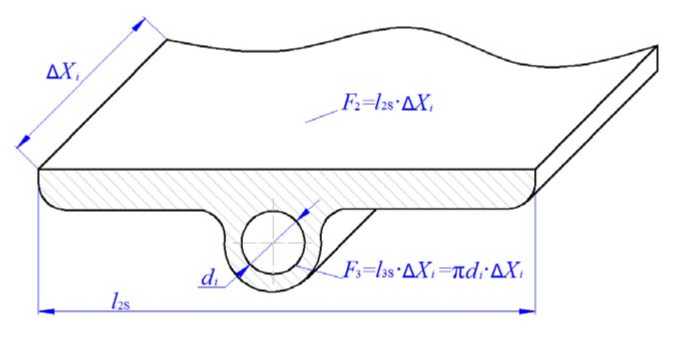
Fig. 2. Calculation scheme for determining the equivalent thermal resistance of a liquid circuit pipe
Рис. 2. Расчетная схема для определения эквивалентного теплового сопротивления трубы жидкостного контура
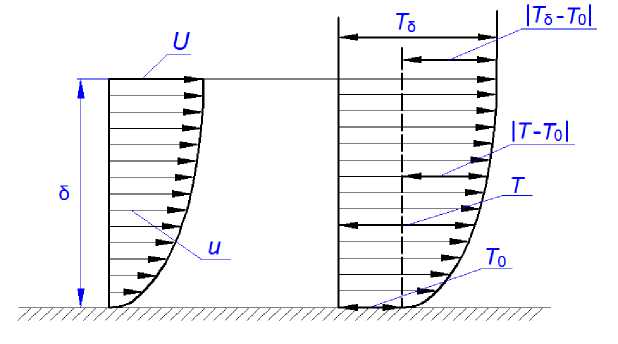
а b
Fig. 3. Calculation schemes: a – dynamic boundary layer; b – temperature boundary layer
Рис. 3. Расчетные схемы:
а – динамический пограничный слой; б – температурный пограничный слой
The final thermal resistance that is the resistance of convective heat transfer to the heat and mass transfer liquid circuit is determined from the last term of equation (5): a i- N F 3i- T, - TM ) = Q i ,
where α i is the local heat transfer coefficient, T 3 i , T 4 i are the pipe wall and coolant temperatures at the integration step. After substituting Δ F 3 = Δ x i ∙ l 3 we get
We consider the Navier-Stokes equations in cylindrical coordinates:
n (п д UR+U 0d UR+T J 8 U R U 00 8 p.
p Up 1+ U = Fp +
( R д R R д0 Z д Z R J R д R
(5 2 U r 1 5 2 U r д 2 U r 1 д U r 2 д U 0 U r )
+ Ц ++1 ,
I д R 2 R 2 д0 2 д Z R д R R 2 50 R 2 I
R M4 i =
a i • l 3 5 'A x i "
The main computational complexity in equation (10) is the determination of the value of the local heat transfer coefficient at the boundary of the coolant flow and the pipe wall. Further, we obtain an analytical dependence for determining the heat transfer coefficient.
Determination of the calculated ratio for the local heat transfer coefficient. We analyze the steady laminar flow in the section of a round cylindrical pipe of a liquid circuit. We take into account that in the theory of convective heat and mass transfer [9–11], for the integral characteristic of wall heat transfer processes, the concept of the thickness of energy loss (or the thickness of the temperature boundary layer, see fig. 3) is used, which is defined by the expression for the straight section of the flow. It is written as:
( д U 0 U 0 0 U 0 д U 0 UrU 0 )
p Up 1+ U 1= F^
( R дR R д0 Z дZ R I
1 9p +
R 00
+ Ц
( d2 U 0
( d R2
1 d U 0
R 2 502
d 2 U 0
dZ2
1 d Uy, 2 d UR Up
0 R 0
R dR R 2 50 R 2

T - T o T S" T o
dy ,
where δ is the thickness of the dynamic boundary layer; δ t is the thickness of the temperature boundary layer; u is the thickness velocity of the boundary layer; U = u | y =δ is the velocity at the outer boundary of the boundary layer (velocity in the flow core); T is the temperature along the thickness of the boundary layer; T 0 = T | y =0 is the temperature on the inner wall, T δ = T | δ=0 is the temperature in the flow core (at the boundary of the boundary layer).
In most calculation and analytical studies [12], the assumption is made that the temperature and dynamic boundary layer are equal at Pr = 1, while the variable parts of the profiles are identical:
f ( u_ ) = ( T - T o ) I U J ( T 8- T , J,
therefore, knowing the function f ( u / U ), we can define f ( T ) .
We determine the velocity distribution function using the basic equations of motion in the boundary conditions of a round straight pipe [13], we use the cylindrical coordinate system shown in fig. 4.
We assume that the streamlines are straight lines parallel to the axis Z , then U R = U Θ = 0; U z ≠ 0. Continuity equation
d UR 1 d U p, d U7 U„ „
—R +--0 + — Z- + — R = 0
d R R 50 д Z R
is converted to
д-^ = o.
д Z
(it 8 UZ p U„ —— +
I R 0 R
U0 0U^ + 5 U , ) = F
R 00 Z d Z ) z
5 p " Z
d 2UZ 1 д 2u г d 2UZ £ d UZ д R 2 R 2 д0 2 д Z 2 R д R
where UR , UZ , U Θ are the velocity projections on the coordinate axis, F is the volume force, ρ is the density, μ is the viscosity.
From the axisymmetric condition it follows that the terms ∂/∂Θ and ∂2/∂2Θ equal zero. Assuming the absence of the action of volume forces, equations (13) will be significantly simplified:
д P д 8P д 8P ( д 2 U z
= 0;— = 0; + ц Z дR д0 дZ ( дR R2
1 д Uz ) .
+--- = 0
R д R J
For the problem statement under consideration, the pressure depends only on the coordinate Z . Taking into account the expression for the product differential, we transform the last equation to the form in full differentials:
1 d ( n dU ) 1 dp
1 R I = , RdR ( dR | ц dZ
since
1 dp ц dZ
is a constant when integrating over R , we
integrate the left and right sides:

obtaining:
„ dU R 2 ( 1 dp ) _
R= + Ci dR 2 (ц dZ J 1
We take the repeated integral f dUdR = f R (1 dp) dR + [CdR,
J dR J2 (ц dZ J J R
and finally we have:
U = X dpR 2 + C 1 ln R + C 2. (16)
4 ц dZ
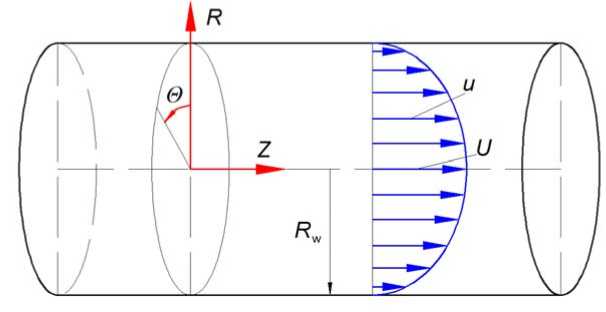
Fig. 4. The coordinate system and the calculation scheme of flow in a round pipe
Рис. 4. Система координат и расчетная схема течения в круглой трубе
It is seen that at R→ 0 we have the expression U→–∞ , which does not have physical meaning, therefore С 1 is equal to zero and we seek for С 2 from the boundary conditions U ( R w ) = 0 (equality of speed to zero on the pipe wall, where R w is the radius of the pipe (cylindrical wall)), then
C = -—dpR2,(17)
and the expression for the distribution of speed takes the form:
U = ± dp (r2 - R ),(18)
4ц dZ w’
We take into account that on the axis of the pipe ( R = 0) the speed has maximum value:
u=-г dPRw.(19)
4 ц dZ
In relative form, the expression for the velocity distribution for the laminar flow has the form:
u 1 R 2
U= " r w
In the theory of the boundary layer, the coordinate y is usually used (as an internal normal to the wall)
y = R w - R ,
if the flow is steady, the boundary layers are closed along the axis of the pipe,
3 = Rw, . (22)
Using expressions (21) and (22), the law of distribution of the velocity parameter over the thickness of the boundary layer of the laminar flow takes the form:

In view of (23), the distribution law of the temperature boundary layer is similar:
The expression for the integral relation of the energy equation (hereinafter – the energy equation) of the temperature boundary layer has the form [14]:
1 5 ( 5 1 ф ) + 1 d ( 5 1 ф ) + 1 d H ф 3 +
Hф 5(Ф) Hv dV HфHv дф tф ф v ф v (25)
+ 1 д H ф 5 = а тФ о (1 + £ )
Hфhv dv tv pCpU pCp(T5-To), where φ, ψ are the axes of the natural coordinate system, δtφ is the thickness of the energy loss of the temperature boundary layer in the longitudinal direction, δtψ is the thickness of the energy loss of the temperature boundary layer in the transverse direction, ρ is the density, Cp is the heat capacity, St = α/(ρCpU) is the Stanton number.
We make the following assumptions: the radius of curvature of the streamline is R curv →∞, which corresponds to a straight streamline; we neglect the dissipative term
Тф0 | 1 + e2 I pc^ IT5- To J, in equation (25), since the thermal equivalent of friction will be taken into account when the equations of motion and energy are integrated along the length of the circuit. Given that the Lame coefficients is Hφ = Hψ = ∂δi/∂Xi = 1, then ∂Hφ/∂ψ = ∂Hψ/∂φ = 0. For a one-dimensional flow, the terms with ∂/∂ψ are 0. Based on the assumptions made, the energy equation of the temperature boundary layer for a linear flow will take the form:
— (5, ф) = ^^ = St . (26) дф t ф p CpU
Equation (26) is not determined by the number of variables. It is necessary to establish the relation α = f (δ), the so-called heat transfer law, similar to the law of friction τ 0φ = f (δ φ ) of the dynamic boundary layer. We take into account that the heat conduction and heat transfer mechanisms are involved on the pipe wall ( y = 0):
T — T o T - T o


= a ( T 5 - T o ).
y =0
Since temperatures T 5 , T0 are constant (given) values, to determine α it is necessary to know the distribution function T = f ( y ) and determine its derivative at y = 0. We use the obtained profile (24) and transform (27) to the expression:
We integrate equation (36) in the range from 0 to the current values:
5? Ф 4 X
J 5 1 Ф d 5 1 ф=^ — d ф ,
0 015 np C p
. d [ t - t a = X— ---- dУIT5- To
.
У =0
5 t ф 4 Xф
----=--.
2 15 p C p
The derivative ∂/∂ y , taking into account (24), takes the form:
2f T - T ) d У I T 8- T o J
5 У
1 -
-
y
У =0 =
? fi У If 1 1 -2 fi У 1 -2
2 1 =— 1 -— = .
( 55J „ 5( 5 J „ 5
x 7X7 У =0 x 7 У =0
We determine the relationship between the thickness of the temperature boundary layer 5 t ф (thickness of energy loss) in the longitudinal direction and the thickness of the boundary layer 5 .
We take into account expressions (27), (28), (29) and use the expression for the thickness of the energy loss in the form:
55f 2
5Z = - 1 1 - TT 0 1 dy = 1 -| 1 - У I | 1 - У | dy , (30)
t ф
0 U к T T 5 J 0 к к 57 к 5JJ
we change the variables: Z = 1 - У ; dZ = - — and carry 5 5
out the integration within the limits of Z1 = 1; Z2 = 0.
Then the integral (30) takes the form:
5 1 ф =
—I
■ 5 J ( 1 - Z 2 ) Z 2 dZ = 5 —
1 5
Z 3
1 J
finally we have a ratio of thicknesses
5.,= f 5 (32)
In view of (32), relation (31) takes the form:
d f T - Tl I = ±X. (33)
dyVт8 - T 15 5„.
z x 5 0 / У =0 t ф
The heat transfer coefficient α (taking into account equation (33)) and the Stanton number are determined as functions of the thickness of the temperature boundary layer:
4 X a =-- ,
15 5 1 ф
a 4 X
p C p U 15 p C p U 5 1 ф
Accordingly, the energy equation (26) takes the form determined by the number of variables:
d /5 x 4 X dф( tф) = 15 pCpU51ф
.
Finally, we obtain the expression for the thickness of the energy loss of the temperature boundary layer in the transient conditions (for the variable coordinate φ):
5 1 ф
0,5
8 Xф
15 p CpU
Then, the convective heat transfer coefficient in a round pipe in a section of unsteady flow (δ < R 0 ) taking into account the heat transfer law (37) is determined by the expression:
4 X a =--
15 5 1 ф
4 XP15 p C p U I 0,5
15 8 Xф
;
a =
2 Xp C p U I 0,5
15 ф
We take into account that δ = R 0 over the length of the steady flow φ = φ st and then remains constant at R 0 = const, then according to (38)
2 _
5 1 ф = 15 R 0 (39)
substituting (38) in (39) we obtain fL R I2 = A Xфst к 15 0 J 15 pСpU,
the length of the steady flow section is defined as:
ф st
2 p c p U
30 X
R 0 2 .
The heat transfer coefficient in the steady state, taking into account (39) and (40), takes the form:
a =
2 x p cpu 1 0,5
15 ф st _
;
a =
0,5
2 Xp CpU 30 X ’
15 p CpU
;
finally we have the value of α in the steady-state area:
2 X
. R 0
Thus, equation (41) determines the value of the local heat transfer coefficient during the flow of coolant inside the channel of the liquid circuit. Together with the thermal equivalents of the honeycomb panel and the LC pipe, the local heat transfer coefficient forms the determining thermal resistance for the TCS section. Using the values of the determining thermal resistances, it becomes possible to carry out numerical studies of heat transfer in the liquid circuit of the temperature control system for given boundary conditions [15].
Conclusion . The considered methodology for calculating the determining thermal resistances for the model of spacecraft TCS liquid circuit based on the characteristic surfaces of constant temperatures makes it possible to
obtain numerical values of the TCS equivalents for the system of thermal balances presented in [5]. This approach makes it possible to obtain a closed system of equations for the LC determined by the temperatures of the northern and southern panels of the TCS and allowing a numerical study of the heat transfer process in the circuit. The specific implementation of the method depends on the boundary and initial conditions for the functioning of the LC and is a promising area of research in the framework of the issue of developing computational tools for modeling TCS.
Список литературы Determining thermal resistance in the model of the liquid circuit of spacecraft thermal control system
- Meseguer J., Perez-Grande I., Sanz-Andres A. Spacecraft thermal control. Cambridge. UK: Woodhead Publishing Limited, 2012. 413 p.
- Gilmore D. G. Spacecraft thermal control handbook. The Aerospace Corporation Press, 2002. 413 p.
- Крушенко Г. Г., Голованова В. В. Совершенствование системы терморегулирования космических аппаратов // Вестник СибГАУ. 2014. № 3 (55). С. 185-189.
- Chebotarev V. E., Zimin I. I. Procedure for evaluating the effective use range of the unified space platforms // Сибирский журнал науки и технологий. 2018, Т. 19, № 3, С. 532-537. 10.31772/2587-6066-2018- 19-3-532-537. DOI: 10.31772/2587-6066-2018-19-3-532-537
- Two-dimensional thermal model of the thermal control system for nonhermetic formation spacecraft / F. V. Tanasienko, Y. N. Shevchenko, A. V. Delkov и др. // Сибирский журнал науки и технологий. 2018, Т. 19, № 3. С. 445-451. 10.31772/2587-6066-2018- 19-3-445-451. DOI: 10.31772/2587-6066-2018-19-3-445-451

